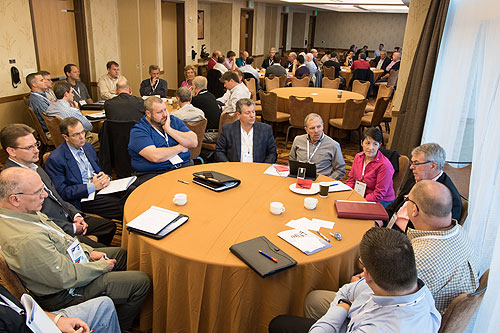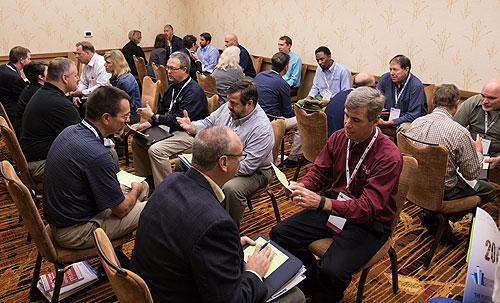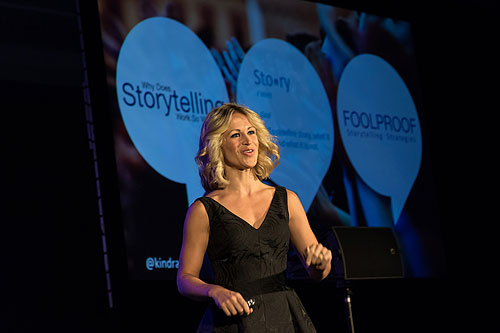MAPP's Annual Benchmarking & Best Practices Conference: The Power of Influenc
Plastics Business
What could you accomplish if you started each day with an attitude of gratitude? What would your leadership style look like? What would your organization look like? How would employee attitudes change if the attitudes of those leading the company changed? MAPP Executive Director Troy Nix opened the 2015 Benchmarking & Best Practices Conference by sharing the ways in which starting each day with intentional gratitude has shaped his effectiveness as a leader. Keying off of the conference theme – The Power of Influence – Nix advocated for influence that starts with positivity at the top of the company food chain and trickles down to impact each and every person within an organization.
This message was heard by the more than 500 attendees who converged on the JW Marriott in Indianapolis, Indiana, for the 2015 MAPP Annual Benchmarking & Best Practices Conference, held Oct. 22-23. The Power of Influence was felt through inspiring keynote speeches, peer-to-peer discussions on issues common to every molding facility and exchanges with industry experts in economics, behavioral change and market trends.
While the keynote speakers offered insights to impact and influence every level of an organization, much of the value of this event was realized when plastics molders from across the US shared the knowledge earned through trial and error in their own organizations. Leaders from plastics processing companies talked to fellow attendees about
- mold maintenance strategies that saved one injection molder more than $200,000 over a three-year time period (read full story here);
- adding camera equipment to an injection molding line as a visual management technique in a way that was embraced, rather than reviled, by employees;
- pre-hiring assessments that are used to screen job applicants to increase the chances of a successful hire; and
- building the ideal manufacturing organization from the ground up by integrating new technology, changing work flows and addressing health and safety issues.
On the second morning of the conference, attendees gathered with peers with similar job descriptions to ask for feedback on one issue pertaining to their day-to-day routines. Operational and processing personnel discussed shift changes, procedure documentation and scrap issues; senior company leaders gathered to talk about training the next generation of management and assessing expansion needs; while human resources professionals talked to each other about training programs, shift incentives and employee retention programs.
The MAPP Benchmarking & Best Practices Conference will return to Indianapolis on Oct. 13-14, 2016.Keynote presentations summaries
Change Behavior – Change the World
Joseph Grenny, VitalSmarts (www.vitalsmarts.com)
“We are hopelessly naïve in understanding why people do what they do, so we are staggeringly inept at helping them change behavior.” – Grenny
Author and speaker Joseph Grenny set out to change the way attendees change minds. In a society that loves quick fix answers to complex problems, Grenny explained that until the influence issues behind behavioral reactions are understood, changing minds isn’t possible.
Whether approaching a problem at work or a problem at home, the problem-solvers – or influencers – first must look beyond the “easy” answers. The ability to change behavior, he explained, is predicated on understanding why the behavior is occurring in the first place. Once the reasons have been diagnosed, influential impact can occur.
Using six sources of influence, Grenny taught attendees the scientifically-quantified methods for influencing behavior, providing step-by-step blueprints for increasing productivity, shaping culture and resolving conflicts by understanding how best to influence others toward positive change. Attendees also were given one of Grenny’s books, “Crucial Conversations: Tools for Talking When Stakes are High.”
The Power of Purpose
Chris Reitzug, Roche Diagnostics (www.roche.com)
Chris Reitzug first understood the power of purpose when he went into a manufacturing facility making the AccuCheck Advantage meter for diabetes care for Roche Diagnostics. When celebrating a production milestone, Reitzug toured the plant, met the people who worked on the production line and told them stories about the health impacts of diabetes and how the meter was helping the people using the product – maybe even someone they knew – live longer, better and healthier lives. Two weeks later, the plant manager called to report record productivity levels, record quality levels and zero absenteeism. These employees were no longer coming to work to punch a timeclock and take home a check; instead, they were coming to work to improve the lives of people with diabetes.
Reitzug advocated using the power of purpose to live a life that means something to you and to those around you.
- Discover your purpose: Find the passions and strengths that make you the person you are.
- Plant your purpose: Apply those passions and strengths in an intentional manner.
- Be on purpose: Have a great attitude, give exceptional effort, rise above the circumstances and care deeply about the people in your life.
World-Class Customer Service at Blinds.com
Steve Riddell, Blinds.com (www.blinds.com)
Steve Riddell is the chief operating officer for Blinds.com, the largest e-commerce organization in Houston, Texas, with sales of $100 million. He is an entrepreneur and motivational speaker who has been credited with leading Blinds.com to receive awards that reflect on cultural and customer service excellence, including Best Places to Work in Houston, Most Engaged Workplace in America and Best Call Center in the US.
Riddell’s presentation was a lesson focused on his role in growing Blinds.com through exceptional customer service that often may have seemed unnecessary when compared to its competitors’ practices. As a company that does not make its own product, warehouse its own product or ship its own product, customer service was the sword by which the company would live or die.
The first step was to stop focusing on today’s sale and, instead, view each customer in terms of lifetime sales and referral sales. As Riddell explained, looking at the lifetime value of the customer changes the way each transaction is viewed. Once that viewpoint changes, the emphasis is not on making quick sales or taking the most calls through the call center, but rather on creating a deep and meaningful customer experience where the customer feels safe in making a purchase decision. Riddell provided guidelines for creating that customer-centric culture.
- World-class customer service for existing customers is cheaper than the money expended to gain new ones. Do not treat customers like a commodity.
- Culture of competency is always better than a culture of compliance. Teach employees to do their jobs well and empower them to make decisions.
- Angry employees make for angry customers. The culture in which employees work becomes the culture in which customers buy – or not.
- Buyers love to buy from companies intent on doing things right. Corporate reputation and community involvement have an impact.
- When customers brag about you, that has a direct impact on lifetime value. World-class customer service leads customers who return in the future and to referral sales.
- In the absence of any other reason to purchase, people choose price.
- Customer service is a profit center, not a cost center. Invest in customer service.
- The key to long-term growth is customer lifetime value.
- When things go wrong, customers will give you the benefit of the doubt. Even if mistakes are made, customers will stay if the situation is handled with honesty.
- When employees are empowered, so is the customer.
Building Customer Relationships through Storytelling
Kindra Hall (www.kindrahall.com)
Anyone can tell a customer that the product will be delivered on time, the original quote will be honored and the quality will be excellent. Customers and prospects hear those things from each and every company with which they interact. By shifting the focus to storytelling, said Hall, customers are shown those qualities in a tangible way. Hall explained that storytelling works because it creates an emotional connection that often leads to action, and stories are memorable long after a recitation of fact fades.
Storytelling can build trust with customers and prospects, enhance communication and grow the brand of companies that use it effectively as a strategy.
Hall said determining what stories to tell could be as simple as thinking about the following defining moments:
- Your “firsts” – first customer, first time molding a product, etc.
- Your proudest moment
- Your biggest challenge
From those moments, craft a story with three simple elements: the “normal,” the “explosion” and the “new normal.” First, set the scene by describing the people and places in the event. Include the emotions felt and specific details. Be strategic in thinking about where the story is heading. Then, describe the moment – the explosion. Finally, describe the new normal. Use a detail from the “normal” to pull the listener back to where you started. Provide a progress report on what was learned from the event. And, finally, offer a directive – a way for the customer or prospect to connect with what was learned through the experience.
With a story to share, customers, prospects and even employees will feel a deeper connection to the words you attribute to your organization. Instead of telling them that the organization has strong family values, a commitment to quality and a willingness to go “above and beyond,” show them through stories that can be told during client meetings, through videos, online via social media or a company website, in print material and through presentations.









